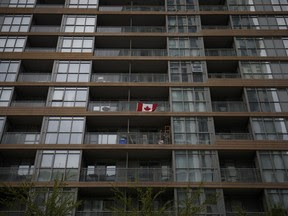Trudeau Is Implementing the Globalists’ Plan to Flood Canada With Third Worlders & Replace the European Founding/Settler People
Diane Francis: Immigration pushing housing, health care to the breaking point
Trudeau’s immigration policies have put a significant strain on large urban areas such as Toronto, Vancouver and Montreal Author of the article: Diane Francis Published Jul 24, 2023 • 3 minute read 30 Comments  A Canadian flag on a condo balcony in Toronto. The city suffers from health-care shortages and unaffordable housing prices. Photo by Cole Burston/Bloomberg
A Canadian flag on a condo balcony in Toronto. The city suffers from health-care shortages and unaffordable housing prices. Photo by Cole Burston/Bloomberg
Prime Minister Justin Trudeau’s push to increase immigration to unprecedented levels is damaging Canada’s health-care system.
The numbers reveal the problem. Last year, Canada welcomed 492,984 new immigrants, all of whom will eventually be issued health cards, entitling them to medical benefits for life. This year, another 465,000 immigrants are set to arrive, plus another 485,000 in 2024 and
Between 2016 and 2021, the Trudeau government admitted a record of over 1.3 million permanent immigrants into the country, all of whom will require medical services. This has put a significant strain on large urban areas such as Toronto, Vancouver and Montreal, which have borne the burden of the influx because they are where the lion’s share of immigrants settle. Toronto and Vancouver, in particular, already suffer from health-care shortages and unaffordable housing prices.
The feds set immigration targets with little regard for skills, the burden placed on social welfare systems or the impact on housing costs. The result is that many hospitals are reaching their limits. Doctors and nurses are in short supply, Canadians face long wait times for specialists and elective surgeries and millions lack a family physician. By clicking on the sign up button you consent to receive the above newsletter from Postmedia Network Inc. You may unsubscribe any time by clicking on the unsubscribe link at the bottom of our emails or any newsletter. Postmedia Network Inc. | 365 Bloor Street East, Toronto, Ontario, M4W 3L4 | 416-383-2300
This is not nearly enough. Financial Accountability Office of Ontario projects that Ontario alone will be short 33,000 nurses and personal support workers by 2028, despite provincial initiatives to boost graduates.
Canada’s immigration levels are disproportionate to other developed nations, taking in about four times as many immigrants as the United States on a per capita basis. To make matters worse, Ottawa’s screening is inept. Despite the staggering immigration numbers, the federal government has failed to address the shortage of skilled labour across the country by recruiting qualified tradespeople.
This push to significantly increase the population was concocted at a weekend gathering in 2011 in Muskoka, Ont., led by Dominic Barton, who served as global managing director of McKinsey and Co. before becoming Canada’s ambassador to China for a time, and former BlackRock Inc. honcho Mark Wiseman. They created a Toronto-based lobbying group called the Century Initiative, which believes Canada’s population should reach 100 million by 2100.
The group estimates that, given sagging birth rates, reaching their arbitrary goal of 100 million would require Canada to accept at least 500,000 immigrants a year, if not more. This has now become our official immigration policy, with the Trudeau Liberals targeting around
The Century Initiative hopes to create “mega-regions,” increasing the population of the Greater Toronto Area from 8.8 million in 2016 to 33.5 million by the end of the century, the population of Metro Vancouver from 3.3 million to 11.9 million and the National Capital Region from 1.4 million to 4.8 million.
Seven years of this foolish Liberal immigration policy has placed a significant strain on the health-care system and housing market. And Canada is going to make matters worse by admitting upwards of 753,000 international students this year, which will further increase the cost of rentals.
A CIBC report last year said that the admission of huge numbers of newcomers in 2022, including an estimated 955,000 “non-permanent residents,” represents “an unprecedented swing in housing demand in a single year that is currently not fully reflected in official figures.”


